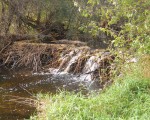
Busy beavers dam up Nippersink Creek, flood cornfields
By Annette Newcomb
Editor
Anyone driving on Twin Lakes Road over the past several weeks may have noticed the water level of the Nippersink Creek has become alarmingly high in recent weeks.
According to Town of Bloomfield Highway Department Supervisor Fed Klabunde, said the high water level is the handy work of a family of beavers who have constructed a lodge about 150 yards from the road.
“I have been working with the highway department since 1993 and every fall we have this problem,” he said Monday.
Klabunde said the township normally takes a backhoe to the site of the dam, if it can get through the wooded area, and then tears it down to free the water, but sometimes area farmers get to it first.
“There are some farm fields down the creek that are in low-laying areas. The farmers need to get the water out of there before they can start harvest so they might get to it before us, you never know.”
One thing is certain, according to the Department of Natural Resources, the beaver are prolific builders and could have a good start on a new lodge within 24-hours of having their current abode destroyed.
Klabunde said it’s the not township’s responsibility to remove the beavers, that’s up the landowners, who in this case live in Alaska.
According to the DNR, beaver populations are considered moderate to low in this corner of the state. Beavers have a natural population mechanism, the DNR reports. While average litters produce four kits, if there is not enough habitat to support the older kits, they do not leave home and subsequent litters are smaller. Statewide the DNR estimated in 2001 there were 79,600 beaver, down from 108,130 in 1998.
Beaver also do not cut down very large pines or massive old trees. They prefer willow, popular, alder and birch. They build dams to create an underwater living environment and also to store food. In deep waters they construct a lodge but do not build a dam.
At the Twin Lakes Road location, Nippersink Creek can trickle just a few inches or get so high the water actually splashes over the bridge desk, depending on the time of year and the amount of rain or snowpack that melts in the spring.
Nippersink Creek begins its journey from Lake Tombeau in Powers Lake and meanders south, taking a very curvy path through Genoa City.
But don’t let its quiet demeanor at that particular site overshadow the fact that the Nippersink Creek watershed is the largest tributary to the Fox River, draining 137 square miles in Illinois, as well as another 50 square miles in Walworth County.
The main channel heads southeast to fill the 830-surface acre reservoir, in Wonder Lake, before flowing back to the northeast and joining its north channel near Spring Grove.
The 87,624-acre Nippersink Watershed empties into Pistakee Lake and is the largest tributary to the Fox River System.
Nippersink Creek is considered among the finest streams in Illinois with the main stem rating a “B” on the Biological Stream Characterization score, while the North Branch, in Walworth County, is given an “A” rating.
It’s doubtful the beaver care about all those stats. They just want a place to call home.
